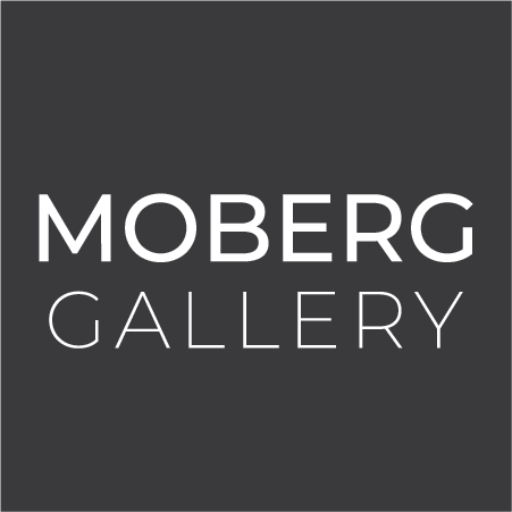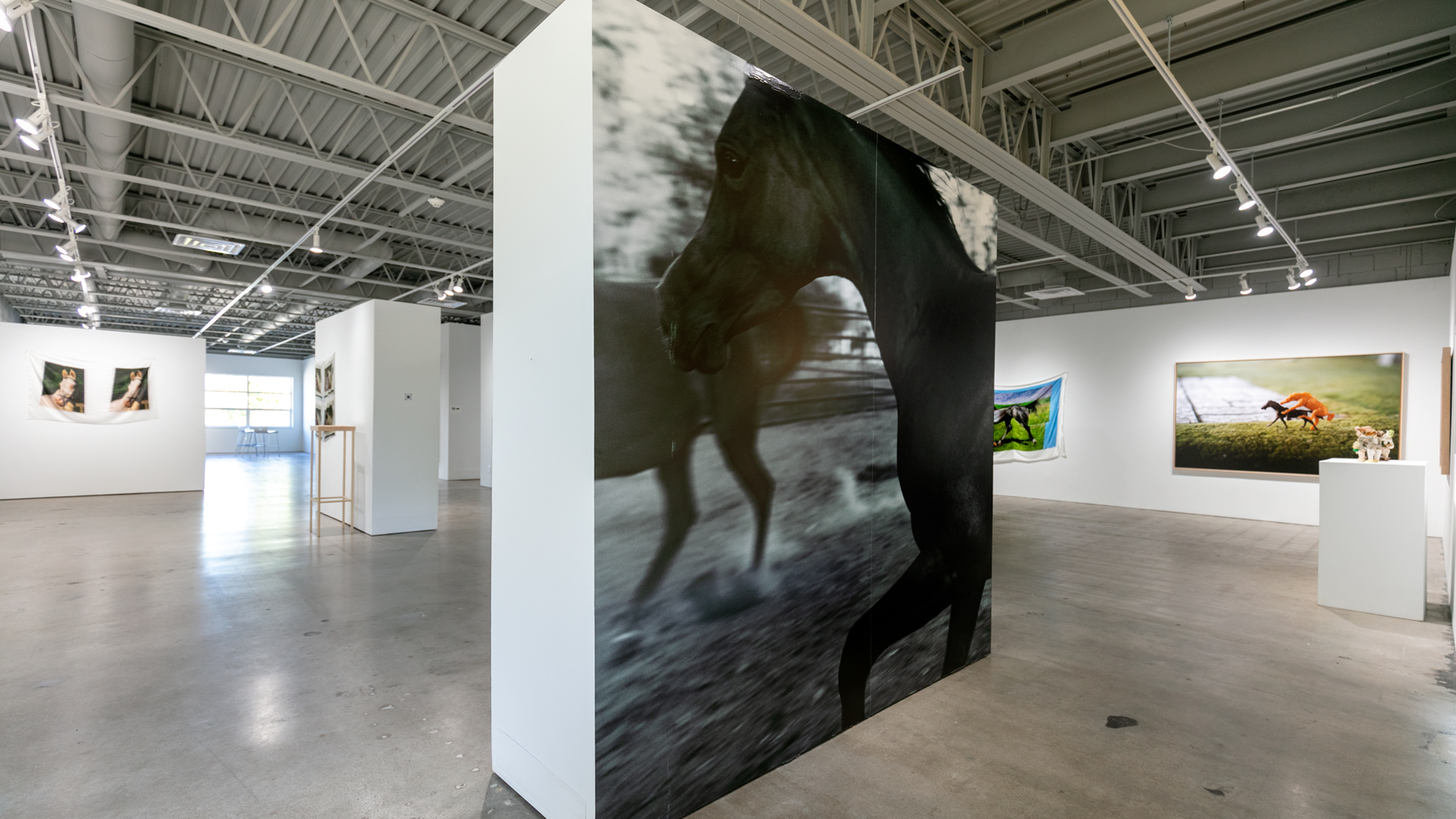Exhibit Documentation Text by Nick LaPole
“Between Earth and Sky” is an exhibit composed of four individuals and one collective. While it consists of varied mediums, the horse remains a fulcrum. Its body, the various pastures in which it resides, and the history that defines these aspects can be seen throughout the exhibit. Intimate, playful, and interrogative, these artists look to the popular mount and explore connections, dramas, and distortions that emanate from it.
Carolyn Hopkins has an established relationship with horses. She owns them, knows them, and in turn they come to know and trust her at the reins. She and her steads are the title personified, and her artwork illustrates an enduring, lifelong commitment to the practice and to a bigger picture.
“Impossible Surrender” proclaims a partnership between mankind and equine most readily. We’ve seen images like this before, where man and beast unite on behalf of conquest. One might expect the ground to tremble under the presence of these two forces but, here, it does not. Instead, the sun greets them warmly along with the charge they carry. That charge is a long, billowing white flag. A declaration of peace, perhaps? The horsewoman is firm, yet the flag flows freely and frames the mountains further on, a range that may in fact stand for a higher power. How fitting, then, to consider this flag a form of deliberate, though uniquely unheard of, submission.
“Treaty” is a flag honored after an arduous journey, potentially in reference to “Impossible Surrender.” While full staff at both ends, the flag and its wielder have experienced much hardship. The dark dye embedded in the fabric reads as sweat and grime. It’s the kind of evidence reserved for hard labor, labor on behalf of a cause bigger than man alone. Strength, grace, and mutual understanding among species; these are the primary subjects, each a trait that transcends fight or flight tendencies and allow a successful completion of an existential task.
Clayton Porter’s engagement with horses is akin to a reminisce, a rumination, a reminder. His lived experience finds a ready metaphor in the horse and jockey, and these metaphors oftentimes manifest in miniature. The scale is the point. While perhaps a speck on a larger canvas, a moment within the grand scheme of things, he articulates their minute effects with the detail often reserved for monoliths.
In “Untitled (Toy Horses)” we see a metaphor play out among figurines. Flesh is replaced with plastic; rolling hills are made out upon domestic carpets. It is here in which two horses gallop together. They flee, fight, play, mount simultaneously, all with the connotation of young love behaving badly. While the photographs are presented like vistas, the mini-forms and bokeh effects hint at danger just outside of frame. These two creatures are at risk of being squashed. They also pose a risk, themselves, Lego-like, ready to harm whoever is unfortunate enough to discover them with bare soles.
“Untitled (Bronc Rider)” manifests many times. One bronc, one horseman, bucking it out on a clean gesso surface. They are tiny, as if to encourage ‘nosy neighbor’ inspections of the conflict. There is resistance to see, sure, but something mutual, too. The fighting is mutual. One version is especially poignant. It consists of three panels: A lone bronc occupies the left panel with a pose that reads as tense and limp; the middle panel is a vacant surface, indicative of a great span of space and time; a lone rider falls on the right panel, as if in hot pursuit of the bronc from earlier. It’s a comic sequence which, in retrospect, feels especially grim. It would be better to see these forces struggle forevermore than to see them separated.
Larassa Kabel’s work depicts horses in the round, either suspended on paperwhite or free flowing on silk fabric. The former depicts them whole. They float on behalf of an audience who subsequently watch their rise and fall in perpetuity. The latter takes observation one step further by isolating parts of the whole and performing all manner of operations upon them. These forms, while hardy, are altered in such a way as to hint at an underlying dysmorphia in the subject.
“Untroubled by Ghosts” is emblematic of Larassa’s drawing oeuvre. Deliberate, detailed, with color pencil applied as precise as a knife and as precious as powder. It falls upon the page, softly. A single pony manifests, in a way that hints at a fall and a leap equally. The ultimate verb is, consequently, up for debate. The subject is suspended. The viewer lingers. Sinews, muscles, individual hairs upon the mane become topics of conversation before, finally, the eye apprehends the looker.
“Two Face” is a digital print on silk. The image is a traditional portrait of a horse, to a point. Prior to printing, its long face is cut, split down the middle. It opens up and reveals a third eye and ear, which appears to blossom from the inside. The horse is still a horse, of course, but irrationally more-so. With funhouse whimsy in the image and fabric aberrations in the material, the subject is revealed to be unsettlingly flexible.
Jim White applies a clever perspective and surreal sensibilities to topics we assume to know already. The truth is much more complicated. With a history of medical interventions under his belt, he himself intervenes among the objects, articles, and general detritus that surround him. Odd juxtapositions and Dada deconstructions define his practice. In this way, the horse acts as an accomplice to his particular brand of revolutionary tomfoolery.
“Eve”, an amalgamation of found objects and binding material, appears to be the origin of ‘horse’ just as Eve is an origin to humanity. She is derived from God’s own image who, against common knowledge and spiritual expectation, is actually just as cobbled together and messy as the rest of us. The sculpture consists of odds and ends, contradictions aplenty, that are at risk of falling apart yet perhaps too confident to imagine ever collapsing.
“Hypocritical Oaf” (a punny title) refers to a Wild West derived from pulpy reads and celluloid entertainment. It’s an image as vibrant and colorful as the day it was painted (and later printed). That doesn’t stop White from going about the work. His adjustments remain subtle, but poignant. The bison, for instance, retains its bison qualities, but it becomes a bandit, too, its face obscured by a handkerchief and hats upon hats adorning its back. Bad hombre, the picture seems to say. The officer, in hot pursuit, agrees wholeheartedly, but he ignores the repetition of the horse head, sprouting up and out of the frame like a soothing justification we tell ourselves to keep us sane and in control. It casts doubt upon the overall argument. The implications are brought to the fore and the details, edited to absurd clarity, become too loud to ignore.
The Belle Morte Collective, consisting of Larassa Kabel and Ben Easter, approach horsemanship from the vantage point of a rodeo. It’s a celebratory habitat, a romantic one at that, and in that romance come questions of authenticity, personal ideals, and the toll it takes on both horse and rider to maintain the illusion. These partners are caught within machinations that are bold, loud, and dramatically lit, which begs the question of who these displays serve and how this pair might perform despite said theatrics.
“Black Hat, White Hat” establishes the relationship between horse and rider just before they take to the stage. The equestrian is a queen, more specifically, and the horse is her attentive companion. In one panel we see their faces, made stark and high contrast by the spotlight. In the other, we see aspects of one and a ghost of the other. A spotted flank of flesh; a cowboy hat shadow branded upon it. It is difficult to look at the display and not read an imposition of one form over another, theatrics impressed upon nature and the human intended to care for her.
“Untitled 3” speaks to the spectacle and disorientation that emerges from the rodeo and, more broadly, the entertainment environment. The rodeo queen, dressed in red tartan and white hat, along with her white steed, pose for the camera. The camera, however, is on the move. Neither the queen nor horse are in focus anymore, given how ravenous the camera is for their good side. Pinpricks of light bleed into glowing strands which repeat among the tassels of the queen’s garb. The upper half of the picture shows her facing away, opposite her charge, while the lower half twists the torso around to keep the feet facing forward. The horse doesn’t know what’s happening; the queen perhaps knows too much and debates whether or not to take her steed and mosey along.









![Between the Earth and Sky 0V9A5277[1]](http://moberggallery.com/wp-content/uploads/2024/09/0V9A52771.jpg)




![0V9A5277[1] 2 0V9A5277[1] 2](http://moberggallery.com/wp-content/uploads/2024/09/0V9A52771-2.jpg)















